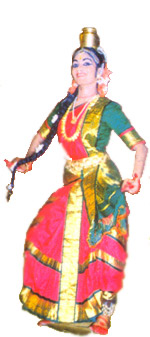|
|

|
|

|
Kuchipudi, one of the art forms of the South had its origin in Andhra Pradesh. It presents scenes from Hindu Epics and mythological tales through dance-dramas combining music, dance and acting.
The lyrics used in Kuchipudi are usually in Telugu, though Sanskrit verses are also not uncommon. While Kuchipudi, like Bharata Natyam comprises pure dance, mime and histrionics, it is the use of speech as well that distinguishes its presentation as dance drama.
 Kuchipudi dance-dramas, each present a particular episode or a series of
episodes. A solo recital, on the other hand, typically consists of such items as
the 'Sabdam', 'Bhama kalapam' which is the main item, 'Padams' and 'Tarangams'. In
'Bhama kalapam', the dancer has enormous scope for the dramatisation of characters. The
main character is Satyabhama, a
beautiful but arrogant queen who goes through the process of discovering the
path of true love and devotion. In the 'Tarangam', the dancer frequently perform a
balancing feat, her feet poised on the edge of a brass plate as she moves
around.
Kuchipudi dance-dramas, each present a particular episode or a series of
episodes. A solo recital, on the other hand, typically consists of such items as
the 'Sabdam', 'Bhama kalapam' which is the main item, 'Padams' and 'Tarangams'. In
'Bhama kalapam', the dancer has enormous scope for the dramatisation of characters. The
main character is Satyabhama, a
beautiful but arrogant queen who goes through the process of discovering the
path of true love and devotion. In the 'Tarangam', the dancer frequently perform a
balancing feat, her feet poised on the edge of a brass plate as she moves
around.
Kuchipudi, a representation of a fine combination of Natya, Nritta and Nritya was earlier never a solo affair and required a number of actors. It was presented in the open air on an improvised stage by men and boys who were given a vigorous training in abhinaya, music, dancing and singing. Earlier the female roles were played by boys and young men of comely appearance. The Sutradhar or the director of the stage played the key role. He was the conductor, dancer, singer, musician, comedian, all rolled into one.
The play began with the orchestral music which included Mridanga, Madala and a pair of cymbals, followed by an invocation to a deity and appearance of Ganesha, the elephant headed god to bless the performance. Then came the dancers offering worship to the Flagstaff or Flag of Indra. The Sutradhara then announced the theme of the play, introduced the characters in his sing-song voice and appealed the audience to witness the show with attention. This marked the end of the prelude and the beginning of the play proper.
Each character entered the stage dancing and singing the merits of the character he or she was impersonating, which is known as 'Daruvus'. The play progressed at a leisurely pace and relaxed tempo punctuated with dances both abstract and expressional. It contained some very complicated items of original footwork such as tracing out an outline of a lion or an elephant with the feet on the floor or dancing with the feet on the edges of a circular brass tray or with a water pot delicately and precariously balanced on the head.
Today Kuchipudi is considerably a different style of dance form than it originally used to be. In most of the cases it is now a solo performance done by female dancers. The Sutradhara has become a phenomenon of the past and the Vachika abhinaya, that is, expressional numbers are sung by the danseuses herself instead by the vocalists in the background on the stage as was the traditional practice. The element of devotion to gods has also been done away with and it has become purely a secular affair with predominance of 'sringar' or erotic flavour. Besides the drama component has also been totally reduced. The main expressional number is from Jaideva's Ashtapadi, the Ramayana, the Puranas, Tirtha Narayana's Krishna Lila Tarangini or Tyagaraja's compositions, but now the dancer combines into herself the roles of the singer who sings the 'daruvu', the actor who speaks the lines and the dancer who mimes and dances to interpret the text. Elements not indigenous to the dance drama such as sculpture like stances and freezes based on perfect iconographic forms motifs and shapes have also been incorporated into Kuchipudi dance recitals to make it more competitive with other dance forms.